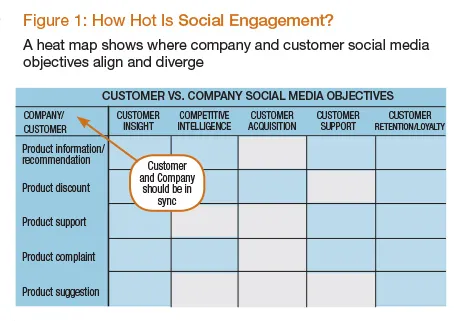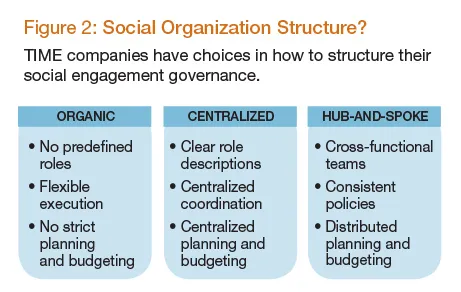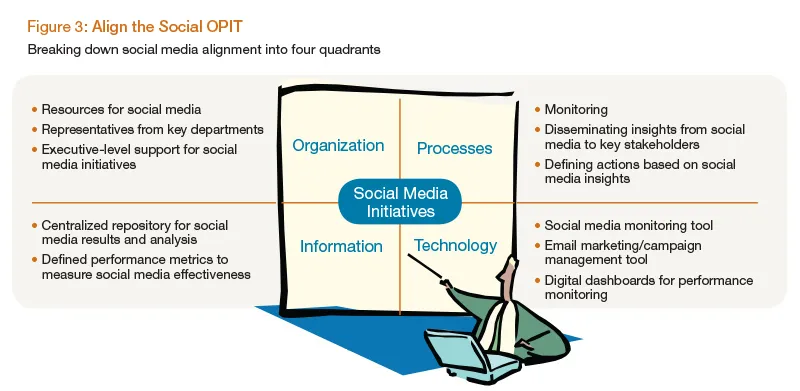Social media has forever changed how customers and companies interact. Companies are eager to embrace social media, but they rarely take the time to set a well-thought-out social media strategy. Not only does this limit the opportunities they capture, but it can also be damaging to their brands. To maximize their ROI from social media, companies need a customer-centric social engagement strategy that aligns with overall corporate and marketing objectives.
Additionally, companies must realize that customers use social media predominantly to engage in interactive one-to-one conversations. Those businesses that use social media efforts only for advertising or sales will find lackluster results. A recent study on FT.com shows that 57 percent of social network users in developed countries dislike receiving advertisements through social media. The lure of social media opportunities should not overshadow the risks and the effort that is required to properly plan and manage corporate social media engagement.
Social media opportunities and risks
There are many opportunities for telecom, Internet, and media (TIME) companies to develop their own unique approach to social media engagement with customers. Just by listening these firms can capture customer insight and competitive intelligence. For example, network security firm Symantec uses social media to drive positive customer product ratings through its "Social @Symantec" microsite, which features forums, blogs, podcasts, and videos, as well as links to its product-specific customer communities and its Twitter and Facebook pages. Additionally, about 10,000 customers participate in Symantec's "Norton Brand Advocates" program; these customers have created more than 1,000 reviews and testimonials, as well as shared more than 2,500 offers with friends and colleagues. Symantec tracks and analyzes those comments, as well as product reviews on e-commerce and specialized websites, and then integrates its findings into its email campaigns. This has contributed to improvements in the average review ratings on e-commerce websites and increased online sales on Amazon.com by $26 million, according to Forrester.
Other players across TIME industries focus on increasing customer satisfaction and driving support costs down through social care. For example, Apple encourages customers to assist one another in its own support communities; others such as HP and AT&T use Facebook support forums to quickly respond to customers.
Yet social media activity is not without risk. It offers detractors a loudspeaker to voice their complaints and vent their frustrations, so companies should be prepared to respond quickly. Additionally, companies must maintain their presence in social channels and ensure that conversations are consistent across channels. A customer-centric social engagement strategy can help. It should have the following three components:
1. Define social media engagement objectives and strategy
Customer and company objectives are not always in sync. While companies may be eager to benefit from customer-driven ideas and innovation over social media, customers may only be on social to research product information and reviews or get customer support. Consequently, there is sometimes a mismatch between objectives and results (See Figure 1). So TIME companies first need to identify and differentiate their current and prospective digital customers, at a minimum by their needs from and expectations of social media. Second, they should clearly define their own social media objectives. Third, they need to design a strategy that helps them achieve their ambitions while catering to customer needs. Finally, it's essential to define specific metrics to assess the return on investment from social engagement.

2. Align the organization, processes, information, and technology
Business leaders need to determine how they're going to structure their company's social engagement governance structure. There are various models (see Figure 2), and each comes with its own advantages and drawbacks. For example, a centralized model can ensure that there is full alignment on all social engagement activities. More decentralized structures (e.g., organic, hub-and-spoke) can be less effective when aligning social activities, but can better engage the entire organization and drive social engagement innovation.

Organization: Truly effective social media initiatives require dedicated resources. Personnel should include representatives from key departments, such as marketing, customer service, corporate communications, and others functions that fall within the scope of the target social media strategy. Companies should train their employees on how best to engage in positive online conversations with customers. It's essential that employees represent the brand well; this includes effective communication, experience investigating customers' requests, and thorough follow-up with customers. Employee empowerment is essential to the success of these efforts. All of this requires support from top management, otherwise cross-organizational alignment and effectiveness will be difficult to achieve.
Process: Senior leadership must determine key processes and SLAs, such as how best to monitor social commentary, disseminate insights to key decision-makers, and address potential action steps. However, it's critical that these processes remain flexible in order to cope with the rapidly evolving nature of social media platforms.
Information: Data captured from social media initiatives should be transferred to other departments through a structured data flow. Companies should collect social data on an ongoing basis, and then use that information to help define, adjust, and leverage their actions in the social media space and elsewhere.
Technology: Technology plays an important role in supporting social media initiatives, in large part because interaction speed is imperative. Companies should leverage social media monitoring tools, as well as platforms for online communities and digital dashboards for performance monitoring. Other systems include marketing and campaign management software and self-service tools.
3. Execute, measure, and refine your customer-centric social engagement strategy
Executing a customer-centric social engagement strategy requires learning and adapting. Social media is rapidly evolving, and so is customer behavior. For this reason program pilots are important, as long as they are well managed and map to a specific objective. Each program's impact will vary by objective, company type, and customer demands.
Adding to this complexity is the evolving nature of the platforms themselves. For example, as Facebook continues to grow with products like places and deals, other platforms, like Google Buzz, are shutting down. Consequently, companies should revisit their social engagement strategy every six months with an update every quarter to check results against performance metrics.
Companies cannot really know whether or how best to change their strategy unless they measure its performance on an ongoing basis. Each objective should have specific metrics attached to it. For example, if the objective is to measure awareness, then number of unique visitors and click-through rates may be good measures. On the other hand, if the objective is to generate new product ideas from customers, then the number of valid ideas and their impact on product sales versus original launch targets is what the company should measure. Each company needs to align social engagement metrics to its overall business goals.
Bringing social engagement to digital customers
In 2011 Peppers & Rogers Group helped a major telecommunications operator create a digital customer agenda. This included producing a customer-centric social media engagement strategy. The project consisted of two components: define customer-centric objectives and strategy, and then design a plan to execute the strategy.
The project included reviewing and revamping all of the telecom's existing social media presences, including Facebook, YouTube, and LinkedIn profiles. Additionally, the project team defined plans to establish a new presence on other social networks, like Flickr and geography-based social networking sites. The strategy focused on developing social media applications that would link directly to information on the operator's products and services. The telecom promoted newly created content, mainly through social media links and widgets on the corporate website and across all related company micro-sites.
The company created a Digital Value Management unit in charge of coordinating and managing all online execution and social media engagement initiatives, including marketing and customer care. The team defined key performance indicators and built a social engagement dashboard to monitor both campaign and employee performance for continuous learning and improvement.
With a sound social engagement strategy in place, the company executed various campaigns to test the impact of social engagement on customer acquisition. In the case of one product, Facebook campaigns resulted in a 184 percent increase in the number of fans of that product and a 5 percent increase in Internet traffic in less than two weeks.

The future is wide open
It's difficult to guess where social media will go. However, what we do know is that companies should avoid broad, unstructured initiatives. Programs with no clear vision or return on investment may create detractors rather than followers and advocates. It's imperative to put a dynamic, long-term plan in place for sustained customer-centric social engagement. That plan must be part and parcel of a broader digital customer agenda and in line with the company's overall corporate and marketing objectives.

















